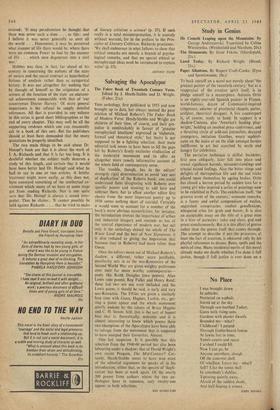Salvaging the Apocalypse
The Faber Book of Twentieth Century Verse. Edited by J. Heath-Stubbs and D. Wright. (Faber, 21s.)
THIS anthology, first published in 1953 and now brought up to date, has always seemed the poor relation of Michael Roberts's The Faber Book of Modern Verse. Heath-Stubbs and Wright are children of their time, of course, and their pre- judice is unmistakably in favour of 'genuine metaphysical intuitions' expressed •in 'elaborate, formal and rhetorical style,' but theirs is not supposed to be a fighting selection; their main editorial task seems to have been to fill the gaps left by Roberts's firmly exclusive vindication of the modernist movement and to offer an altogether more tamely informative account of, the whole field of contemporary verse.
The trouble, though, lies in the editors' strangely rigid determination to avoid 'any sort of duplication' of the Roberts book; one.could understand them disagreeing with Roberts over specific poems and wanting to add here and subtract there, but to allow another editor first choice from the most important poetry up to 1936 seems nothing short of suicidal. Certainly it would seem to account for a number of the book's more obvious eccentricities; for instance, the introduction stresses the importance of urban and industrial imagery and reminds us too of the central experience of modern war, but not only is the anthology denied the whole of The Waste Land and the best of New Signatures, it is also reduced to giving the impression that Sassoon (not in Roberts) had more talent than Owen:
Once the editors move out of Michael Roberts's shadow, a different, rather more justifiable, peculiarity sets in as the neo-Romantics of the Second World War are given weighty preference over their far more worthy contemporaries— poets like Keith Douglas (two poems), Alun Lewis (one poem), Roy Fuller and Henry Reed; these last two arc not even included and the Lewis poem, it should be said, is early and very neo-Romantic. The Fifties are given a similarly lean time with Gunn, Hughes, Larkin, etc., get- ting a poem apiece and the whole movement utterly undone by the talents of Brian Higgins and C. H. Sisson. Still, this is the sort of honest bias that is, theoretically, welcome and it is almost interesting to know which poems these two champions of the Apocalypse have been able to salvage from the movement that is• supposed to have usurped their favourites. Almost.
One last suspicion. Is it possible that this selection from the 1940-60 period has also been labouring under a shadow; that of David Wright's own recent Penguin, The Mid-Century? Cer- tainly, Heath-Stubbs seems to have won most of the editorial arguments he speaks of in his introduction; either that, or the spectre of 'dupli- cation' has been at work again. Of the nearly 200 poems from authors whom the two an- thologies have in common, only twenty-one appear in both selections.
IAN HAMILTON






























 Previous page
Previous page